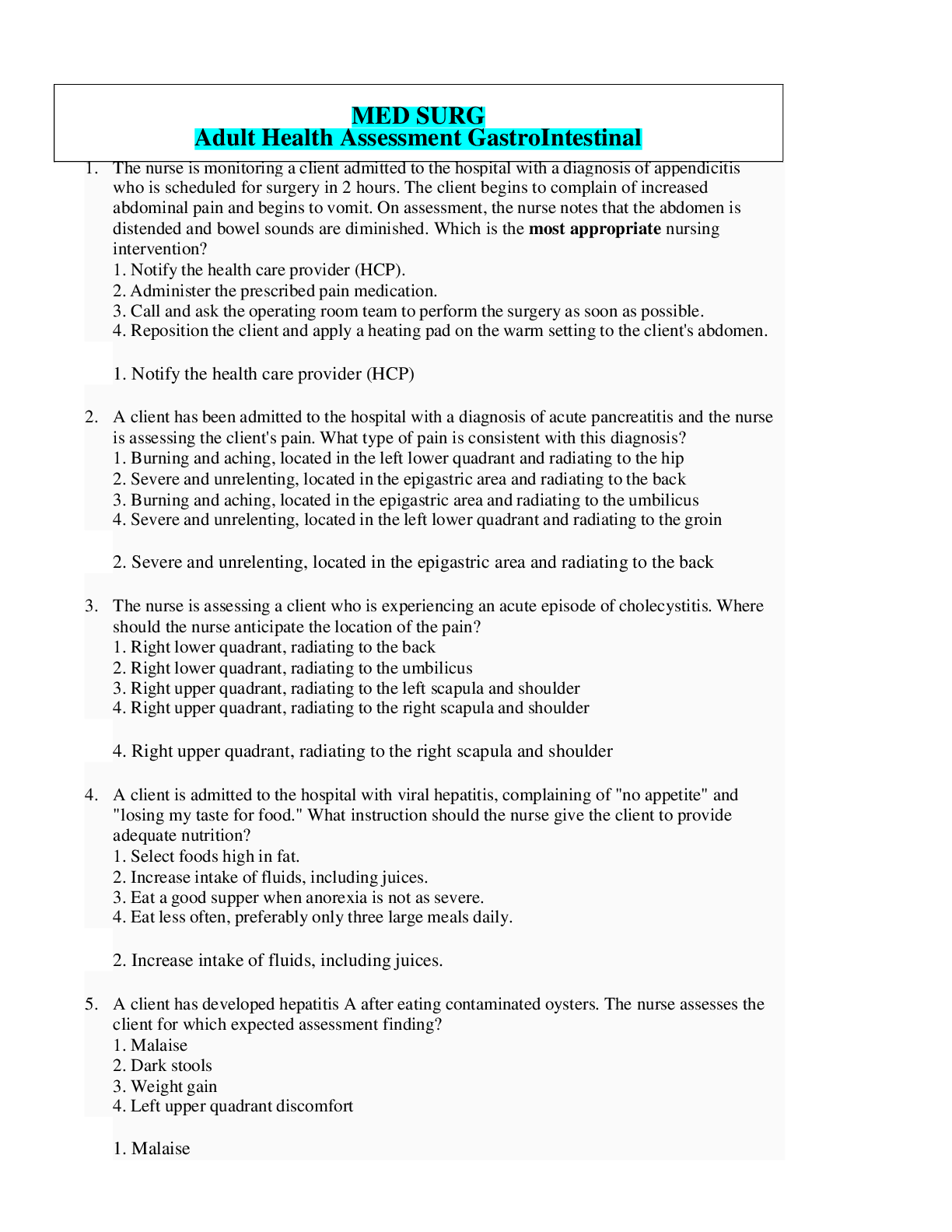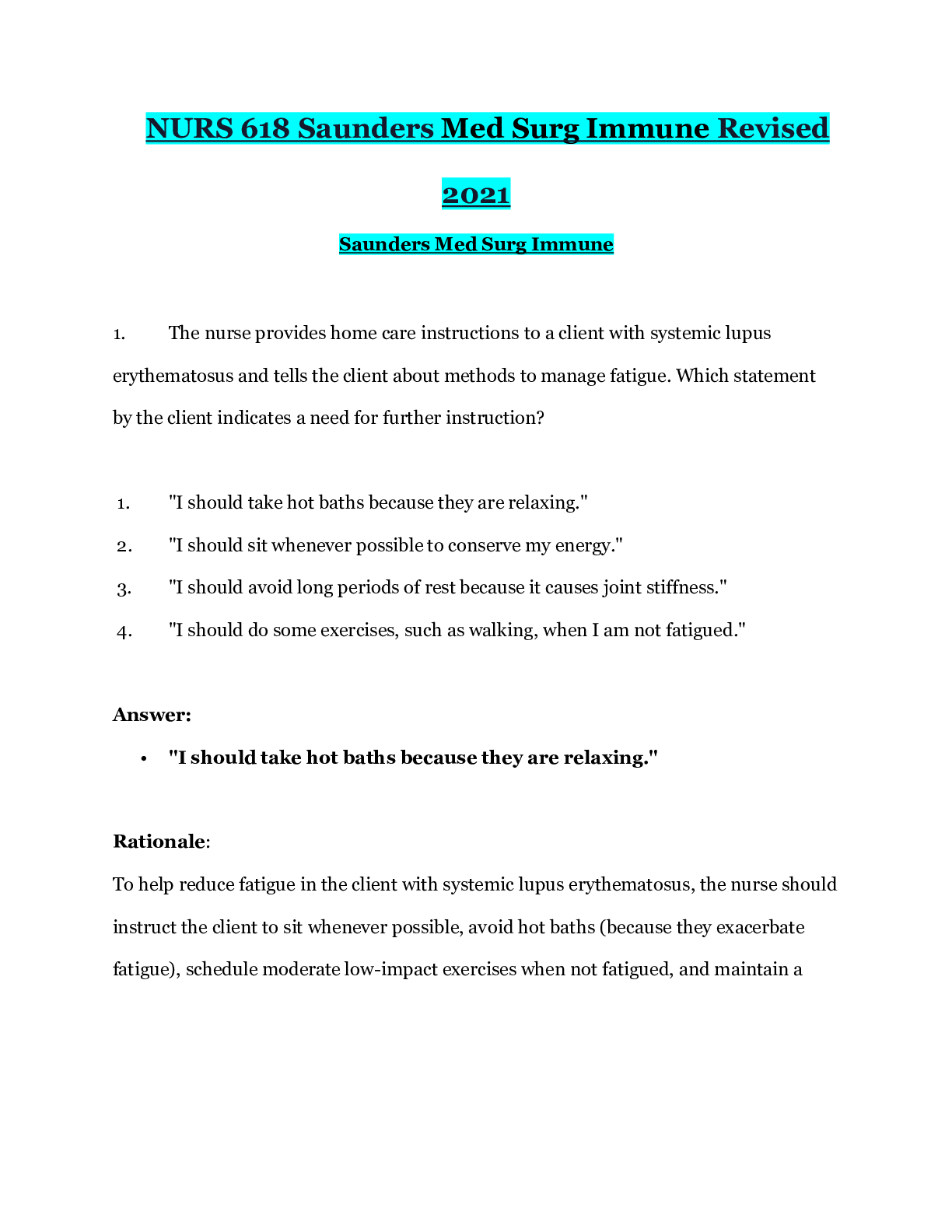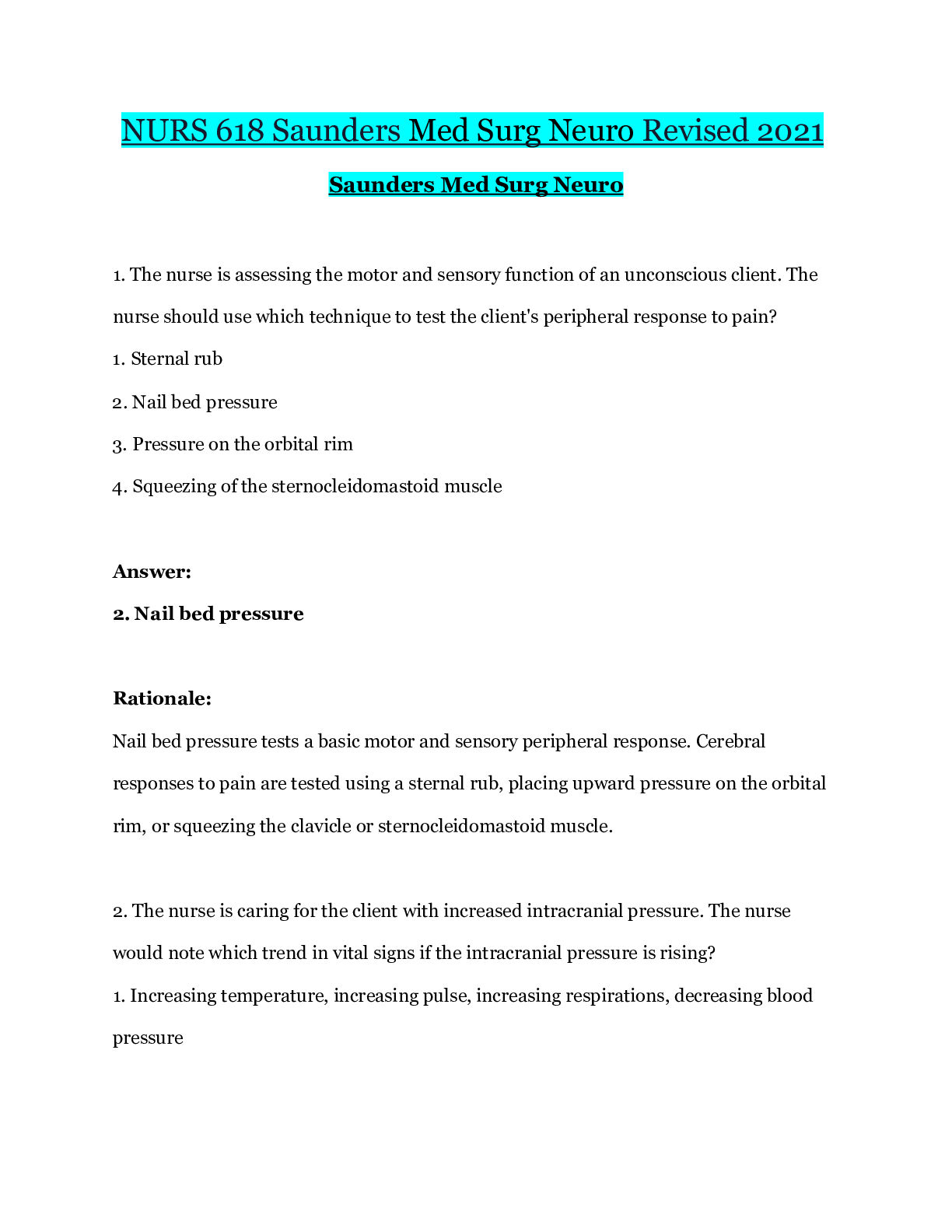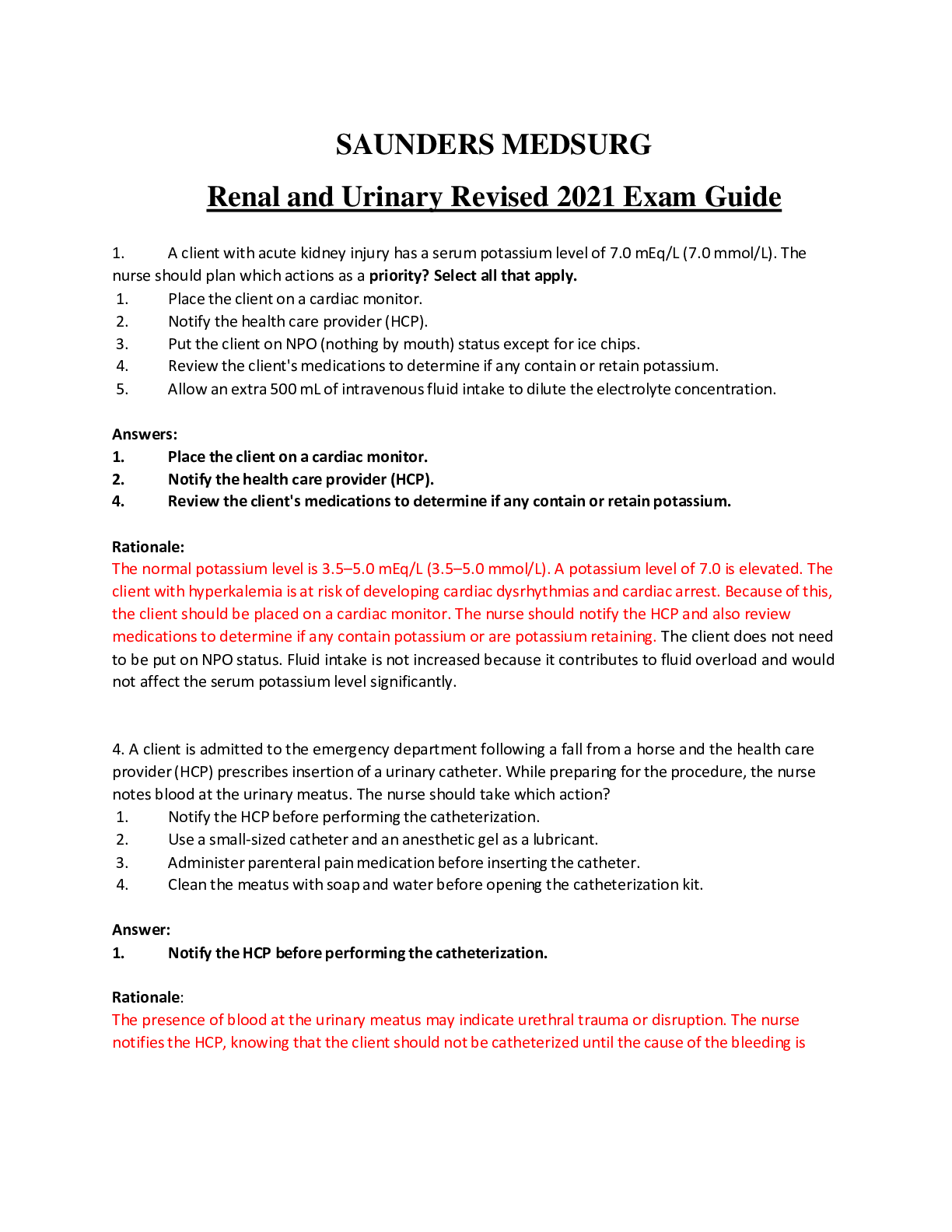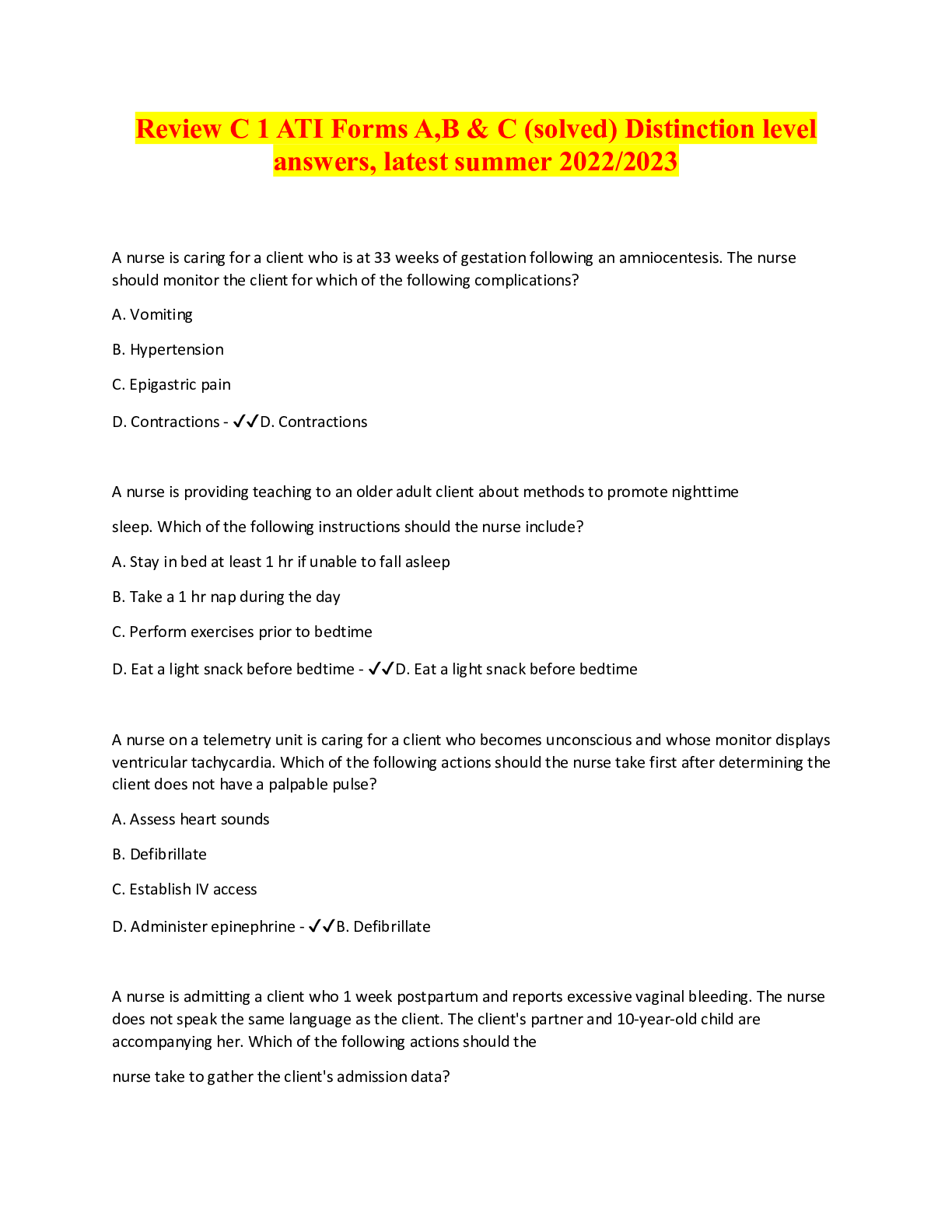*NURSING > QUESTIONS & ANSWERS > Pathophysiology Final Exam Test Bank, full questions and answers, Latest Summer 2020. (All)
Pathophysiology Final Exam Test Bank, full questions and answers, Latest Summer 2020.
Document Content and Description Below
Pathophysiology Final Exam 1. 1. Which action is a purpose of the inflammatory process? 2. What causes the edema that occurs during the inflammatory process: 3. What process causes heat and redness to... occur during the inflammatory process? 4. Which type of immunity is produced by an individual after either natural exposure to the antigen or after immunization against the antigen? 5. What type of immunity is produced when an immunoglobulin crosses the placenta? 6. Which immunoglobulin is present in blood, saliva, breast milk, and respiratory secretions? 7. Which antibody initially indicates a typical primary immune response? 8. An individual is more susceptible to infections of mucous membranes when he or she has a seriously low level of which immunoglobulin antibody? 9. Evaluation of umbilical cord blood can confirm that which immunoglobulin level is near adult levels? 10. Which statement is true concerning the IgM? 11. The common hay fever allergy is expressed through a reaction that is mediated by which class of immunoglobulins? 12. Which component of the immune system is deficient in individuals with infections caused by viruses, fungi, or yeast? 13. Chickenpox (varicella) may be followed years later by which disorder? 14. How is thrush best defined? 15. Which viral disease has an incubation period of 14 to 21 days and duration of 1 to 4 days? 16. Rubella (German or 3-day measles) is a common communicable disease of children caused by what type of organism? 17. Rubeola is a highly contagious acute disease in children caused by which type of infection? 18. Which clinical manifestation is present in rubeola but not in rubella? 19. What is the cause of chickenpox? 20. Which contagious disease is caused by the itch mite? 21. Cystic fibrosis is caused by what type of gene: 22. The difference between DNA sequence mutations and epigenetic modifications is: 23. Maintenance of a constant internal environment and the implementation of behavioral patterns are main functions of which area of the brain? 24. What parts of the brain mediate the expression of affect, both emotional and behavioral states? 25. Reflex activities concerned with heart rate, blood pressure, respirations, sneezing, swallowing, and coughing are controlled by which area of the brain: 26. Which area of the brain assumes the responsibility for conscious and unconscious muscle synergy and for maintaining balance and posture? 27. Which cerebral vascular hemorrhage causes meningeal irritation, photophobia, and positive Kernig and Brudzinski signs? 28. Hypothalamic-pituitary-adrenal (HPA) system abnormalities exist in a large percentage of individuals with: 29. The onset of schizophrenia can be triggered by which prenatal occurrence? 30. Alterations in which part of the brain are linked to hallucinations, delusions, and thought disorder associated with schizophrenia? 31. Which nutritional deficiency in a pregnant woman is associated with neural tube defect (NTD)? 32. Children with phenylketonuria (PKU) are unable to synthesize: 33. Hemophilia B is caused by a deficiency of which clotting factor? 34. Which disease is caused by clotting factor VIII deficiency and is an autosomal dominant trait? 35. The release of catecholamine by the adrenal glands compensate for which initial effects of hypovolemic shock? 36. In cardiogenic shock, what is the cause of hepatomegaly and periorbital edema? 37. Which normal physiologic change occurs in the aging pulmonary system? 38. Clinical manifestations of inspiratory and expiratory wheezing, dyspnea, nonproductive cough, and tachypnea are indicative of which condition? 39. Clinical manifestations of decreased exercise tolerance, wheezing, shortness of breath, and productive cough are indicative of which respiratory disorder? 40. Clinical manifestations that include unexplained weight loss, dyspnea on exertion, use of accessory muscles, and tachypnea with prolonged expiration are indicative of which respiratory disorder? 41. Clinical manifestations of inspiratory crackles, increased tactile fremitus, egophony, and whispered pectoriloquy are indicative of which respiratory condition? 42. What is the first sign of puberty in girls? 43. What is the first sign of puberty in boys? 44. In the 95% of those with delayed puberty, the problem is caused by which condition? 45. What term is used to identify an inflammation of the glans penis? 46. What is the most common infectious cause of orchitis and one that usually affects post pubertal boys? 47. Priapism has been associated with the abuse of what substance? 48. With which medical diagnosis is meconium ileus often associated? 49. Which term is used to describe an intestinal obstruction caused by the invagination of the ileum into the cecum and part of the ascending colon by collapsing through the ileocecal valve? 50. Cystic fibrosis is characterized by which symptom? 51. Which medication compensates for the deficiency that occurs as a result of cystic fibrosis? 52. What causes a person with cystic fibrosis to experience an exocrine pancreatic insufficiency? 53. Which disorder is characterized by damage to the mucosa of the duodenum and jejunum and impaired secretion of secretin, cholecystokinin, and pancreatic enzymes? 54. What factor associated with gluten-sensitive enteropathy (celiac sprue) causes an infant to bruise and bleed easily? 55. Which structure attaches skeletal muscle to bone? 56. Lead poisoning affects the nervous system by: 57. Considering the pathophysiologic process of postmenopausal osteoporosis, which changes are believed to play a significant role in the development of age-related bone loss? 58. What are the primary goals for the treatment of shock? 59. Graves disease develops from a(n): 60. Pathologic changes associated with Graves disease include: 61. The level of thyroid-stimulating hormone (TSH) in individuals with Graves disease is usually: 62. Which neurotransmitter is reduced in people with schizophrenia? 63. A decrease in receptor binding for which neurotransmitter is found in individuals with depression? 64. Autonomic hyperreflexia-induced bradycardia is a result of stimulation of the: Carotid 65. Which bone cell secretes hydrochloric acid to help dissolve bone minerals and collagenase, thus aiding in the digestion of collagen? 1. Activation of the classical pathway begins with: a. Viruses c. Mast cells b. Antigen-antibody complexes d. Macrophages 2. The chemotactic factor affects the inflammatory process by: a. Causing vasodilation around the inflamed area b. Stimulating smooth muscle contraction in the inflamed area c. Directing leukocytes to the inflamed area d. Producing edema around the inflamed area 3. In the later stages of an inflammatory response, which phagocytic cell is predominant? a. Neutrophils c. Chemokines b. Monocytes d. Eosinophils 4. Which cell is the body’s primary defense against parasite invasion? a. Eosinophil c. T lymphocytes b. Neutrophils d. B lymphocytes 5. Which characteristic is the most important determinant of immunogenicity when considering the antigen? a. Size c. Complexity b. Foreignness d. Quantity 6. The B-cell receptor (BCR) complex functions uniquely by: a. Communicating information about the antigen to the helper T cell b. Secreting chemical signals to communicate between cells c. Recognizing the antigen on the surface of the B lymphocyte d. Communicating information about the antigen to the cell nucleus 7. Which is an example of an endogenous antigen? a. Yeast c. Bacteria b. Cancer cells d. Fungus 8. When a person is exposed to most antigens, antibodies can be usually detected in his or her circulation within: a. 12 hours c. 3 days b. 24 hours d. 6 days 9. Why is the herpes virus inaccessible to antibodies after the initial infection? a. The virus does not circulate in the blood. b. It does not have antibody receptors. c. It resists agglutination. d. The virus is a soluble antigen. 10. Which is an example of a bacterial toxin that has been inactivated but still retains its immunogenicity to protect the person? (Select all that apply.) a. Poliomyelitis b. Measles c. Tetanus d. Gonorrhea e. Diphtheria 11. Raynaud phenomenon is classified as a type III hypersensitivity reaction and is due to: a. Immune complexes that are deposited in capillary beds, blocking circulation b. Mast cells that are bound to specific endothelial receptors, causing them to degranulate and creating a localized inflammatory reaction that occludes capillary circulation c. Cytotoxic T cells that attack and destroy the capillaries so that they are unable to perfuse local tissues d. Antibodies that detect the capillaries as foreign protein and destroy them using lysosomal enzymes and toxic oxygen species 12. In which primary immune deficiency is there a partial-to-complete absence of T-cell immunity? a. Bruton disease c. Reticular dysgenesis b. DiGeorge syndrome d. Adenosine deaminase deficiency 13. Raynaud phenomenon is an example of which type of hypersensitivity? a. IV c. II b. III d. I 14. Which statement is true regarding immunodeficiency? a. Immunodeficiency is generally not present in other family members. b. Immunodeficiency is never acquired; rather, it is congenital. c. Immunodeficiency is almost immediately symptomatic. d. Immunodeficiency is a result of a postnatal mutation. 15. What is the role of reverse transcriptase in HIV infection? a. Reverse transcriptase converts single-stranded DNA into double-stranded DNA. b. It is needed to produce integrase. c. It transports the RNA into the cell nucleus. d. It converts RNA into double-stranded DNA. 6. What is a long-term complication of rewarming as a treatment for hypothermia? a. Acidosis c. Shock b. Dysrhythmias d. Renal failure 17. Using a fan to reduce body temperature is an example of which mechanism of heat loss? a. Evaporation c. Convection b. Radiation d. Conduction 18. Prolonged high environmental temperatures that produce dehydration, decreased plasma volumes, hypotension, decreased cardiac output, and tachycardia cause which disorder of temperature regulation? a. Heat cramps c. Malignant hyperthermia b. Heat stroke d. Heat exhaustion 19. Heat exhaustion results in: (Select all that apply.) a. Profuse sweating b. Profound vasodilation c. A need to ingest warm liquids d. Permanent damage to the hypothalamus e. An increased risk for future heat exhaustion 20. The existence of regular, deep, and rapid respirations after a severe closed head injury is indicative of neurologic injury to the: a. Lower midbrain c. Supratentorial b. Pontine area d. Cerebral area 21. What type of posturing exists when a person with a severe closed head injury has all four extremities in rigid extension with the forearms in hyperpronation and the legs in plantar extension? a. Decorticate c. Spastic b. Decerebrate d. Cerebellar 22. Which assessment finding marks the end of spinal shock? a. Return of blood pressure and heart rate to normal b. Gradual return of spinal reflexes c. Return of bowel and bladder function d. Evidence of diminished deep tendon reflexes and flaccid paralysis 23. Which vascular malformation is characterized by arteries that feed directly into veins through vascular tangles of abnormal vessels? a. Cavernous angioma c. Arteriovenous angioma b. Capillary telangiectasia d. Arteriovenous malformation 24. The type of vascular malformation that most often results in hemorrhage is: a. Cavernous angioma c. Capillary telangiectasia b. Venous angioma d. Arteriovenous malformation 25. What are the initial clinical manifestations immediately noted after a spinal cord injury? (Select all that apply.) a. Headache b. Bladder incontinence c. Loss of deep tendon reflexes d. Hypertension e. Flaccid paralysis 26. Which nutritional deficiency in a pregnant woman is associated with neural tube defect (NTD)? a. Iron c. Zinc b. Vitamin C d. Folate 27. Which defect of neural tube closure is most common? a. Anterior c. Lateral b. Posterior d. Midline 28. What is the result of a Chiari type II malformation associated with a myelomeningocele? a. Upward displacement of the cerebellum into the diencephalon b. Motor and sensory lesions below the level of the myelomeningocele c. Downward displacement of the cerebellum, brainstem, and fourth ventricle d. Generalized cerebral edema and hydrocephalus 29. Children with phenylketonuria (PKU) are unable to synthesize: a. Essential amino acid, phenylalanine, to tyrosine b. Renin, erythropoietin, and antidiuretic hormone c. Aldosterone, cortisol, and androgens d. Neurotransmitters gamma-aminobutyric acid (GABA) and acetylcholine 30. What test is performed on amniotic fluid and maternal blood to test for neural tube defect? a. Total protein c. -fetoprotein b. Culture d. C-reactive protein 31. The clinical manifestations of dyskinetic cerebral palsy include: a. Increased muscle tone and prolonged primitive reflexes b. Exaggerated deep tendon reflexes, clonus, and rigidity of extremities c. Scoliosis, contractures, and stiffness of trunk muscles d. Jerky uncontrolled and abrupt fine musculoskeletal movements 32. Which human physiologic system is believed to be an integral factor in unhealthy aging? a. Cardiac c. Central nervous b. Endocrine d. Urinary 33. Diabetes insipidus is a result of: a. Antidiuretic hormone hyposecretion c. Insulin hyposecretion b. Antidiuretic hormone hypersecretion d. Insulin hypersecretion 34. Amenorrhea, galactorrhea, hirsutism, and osteoporosis are each caused by a: a. Posterior pituitary adenoma c. Prolactinoma b. Thymoma d. Growth hormone adenoma 35. Palpation of the neck of a person diagnosed with Graves disease would detect a thyroid that is: a. Left of midline c. Normal in size b. Small with discrete nodules d. Diffusely enlarged 36. Which statements about the human papillolmavirus (HPV) and vaccine are true? (Select all that apply.) a. Currently, two HPV vaccines have been approved for use in the United States. b. HPV is believed to be responsible for the majority of the diagnosed cases of cervical cancer. c. A form of the vaccine has been approved for use in males to prevent genital warts. d. The administration of the vaccine is a one-dose intramuscular injection. e. The recommended age for vaccination of girls is between 11 and 12 years of age. 37. Considering the pathophysiologic characteristics of primary amenorrhea, what anatomic structure is involved in compartment II? a. Ovary c. Hypothalamus b. Anterior pituitary d. Vagina 38. Considering the pathophysiologic characteristics of primary amenorrhea, what anatomic structure is involved in compartment IV? a. Vagina c. Ovary b. Hypothalamus d. Anterior pituitary 39. What is the major concern regarding the treatment of gonococci infections? a. Development of antibiotic resistance c. Changes in pathogenicity b. Changes in virulence d. Mutations into different strains 40. Which sexually transmitted infection frequently coexists with gonorrhea? a. Syphilis c. Chlamydia b. Herpes simplex virus d. Chancroid 41. Which statements are true concerning the sexually transmitted infection (STI) lymphogranuloma venereum? (Select all that apply.) a. Lymphogranuloma venereum is an STI commonly diagnosed in the United States. b. It begins as a skin infection. c. Lymphogranuloma venereum spreads to lymph tissues. d. Primary and secondary lesions are apparent with this STI. e. A 60-day course of oral erythromycin is the recommended treatment. 42. The absence of parietal cells would prevent the absorption of an essential nutrient necessary to prevent which type of anemia? a. Iron deficiency c. Folic acid deficiency anemia b. Pernicious anemia d. Aplastic anemia 43. Which nutrients are necessary for the synthesis of DNA and the maturation of erythrocytes? a. Protein and niacin c. Cobalamin (vitamin B12) and folate b. Iron and vitamin B6 (pyridoxine) d. Pantothenic acid and vitamin C 44. Reed-Sternberg (RS) cells represent malignant transformation and proliferation of which of the following? a. Interleukin (IL)–1, IL-2, IL-5, and IL-6 b. Tumor necrosis factor–beta c. B cells d. T cells 45. Hodgkin disease is characterized by the presence of which of the following? a. Philadelphia chromosome c. Microvascular thrombi b. Virchow triad d. Reed-Sternberg (RS) cells 46. Which type of hemophilia affects only men? a. Hemophilia A c. Hemophilia C b. Hemophilia B d. von Willebrand disease 47. Which hemophilia occurs equally in both men and women? a. Hemophilia A c. Hemophilia C b. Hemophilia B d. von Willebrand disease 48. What is the ratio of coronary capillaries to cardiac muscle cells? a. 1:1 (one capillary per one muscle cell) b. 1:2 (one capillary per two muscle cells) c. 1:4 (one capillary per four muscle cells) d. 1:10 (one capillary per ten muscle cells) 49. Which factor is responsible for the hypertrophy of the myocardium associated with hypertension? a. Increased norepinephrine c. Angiotensin II b. Adducin d. Insulin resistance 50. Superior vena cava syndrome is a result of a progressive increase of which process? a. Inflammation c. Distention b. Occlusion d. Sclerosis 51. What cardiac pathologic condition contributes to ventricular remodeling? a. Left ventricular hypertrophy c. Myocardial ischemia b. Right ventricular failure d. Contractile dysfunction 52. What is the cause of the dyspnea resulting from a thoracic aneurysm? a. Pressure on surrounding organs c. Formation of atherosclerotic lesions b. Poor oxygenation d. Impaired blood flow 53. Which heart defect produces a systolic ejection murmur at the right upper sternal border that transmits to the neck and left lower sternal border? a. Coarctation of the aorta c. Aortic stenosis b. Pulmonic stenosis d. Hypoplastic left heart syndrome 54. Which condition is capable of producing alveolar dead space? a. Pulmonary edema c. Atelectasis b. Pulmonary emboli d. Pneumonia 55. How does chest wall compliance in an infant differ from that of an adult? a. An adult’s chest wall compliance is lower than an infant’s. b. An adult’s chest wall compliance is higher than an infant’s. c. An adult’s chest wall compliance is the same as an infant’s. d. An adult’s chest wall compliance is dissimilar to that of an infant’s. 56. Which statement best describes acute respiratory distress syndrome (ARDS)? a. An obstructive airway disease characterized by reversible airflow obstruction, bronchial hyperreactivity, and inflammation b. A pulmonary disease characterized by severe hypoxemia, decreased pulmonary compliance, and the presence of bilateral infiltrates on chest x-ray imaging c. A respiratory disorder involving an abnormal expression of a protein producing viscous mucus that lines the airways, pancreas, sweat ducts, and vas deferens d. A pulmonary disorder characterized by atelectasis and increased pulmonary resistance as a result of a surfactant deficiency 57. When renin is released, it is capable of which action? a. Inactivation of autoregulation b. Direct activation of angiotensin II c. Direct release of antidiuretic hormone (ADH) d. Formation of angiotensin I 58. What is the action of urodilatin? a. Urodilatin causes vasoconstriction of afferent arterioles. b. It causes vasodilation of the efferent arterioles. c. Urodilatin inhibits antidiuretic hormone secretion. d. It inhibits salt and water reabsorption. 59. A patient exhibits symptoms including hematuria with red blood cell casts and proteinuria exceeding 3 to 5 g/day, with albumin as the major protein. These data suggest the presence of which disorder? a. Cystitis c. Glomerulonephritis b. Chronic pyelonephritis d. Nephrotic syndrome 60. In the mouth and stomach, salivary -amylase initiates the digestion of which nutrients? a. Proteins c. Fats b. Carbohydrates d. Fiber 61. Which pancreatic enzyme is responsible for the breakdown of carbohydrates? a. Trypsin c. Lipase b. Amylase d. Chymotrypsin 62. What is the cause of faulty digestion of fats in those diagnosed with cystic fibrosis? a. Bile ducts obstructed with mucus, prohibiting the release of bile b. Failure to metabolize fat-soluble vitamins c. Deficiency of pancreatic enzymes d. Fat malabsorption that now occurs in the jejunum 63. With which medical diagnosis is meconium ileus often associated? a. Muscular dystrophy c. Cystic fibrosis b. Cerebral palsy d. Congenital aganglionic megacolon 64. Which medication compensates for the deficiency that occurs as a result of cystic fibrosis? a. Salt tablets c. Antihypertensives b. Pancreatic enzymes d. Antibiotics 65. What is the most common clinical manifestation of osteoporosis? a. Bone deformity c. Pathologic fracture b. Bone pain d. Muscle strain 66. The failure of bones to ossify, resulting in soft bones and skeletal deformity, characterizes which disorder? a. Osteogenesis imperfecta c. Osteochondrosis b. Rickets d. Legg-Calvé-Perthes disease 67. Which bones are affected in Legg-Calvé-Perthes disease? a. Heads of the femur c. Heads of the humerus b. Distal femurs d. Distal tibias 68. Which cells of the dermis release histamine and play a role in the hypersensitivity reactions of the skin? a. Histiocytes c. Mast cells b. Fibroblasts d. Macrophages 69. Which inflammatory mediators are active in frostbite? (Select all that apply.) a. Leukotrienes b. Histamine c. Prostaglandins d. Bradykinin e. Thromboxanes 70. Which characteristics allow erythrocytes to function as gas carriers? (Select all that apply.) a. Permanent shape b. Compactness c. Reversible deformability d. Presence of hyperactive mitochondria e. Biconcavity 71. What are the common clinical manifestations of endometriosis? (Select all that apply.) a. Back and flank pain b. Infertility c. Dysuria d. Amenorrhea e. Dysmenorrhea 72. What theory is used to describe the cause of endometriosis? a. Obstruction within the fallopian tubes prevents the endometrial tissue from adhering to the lining of the uterus. b. Endometrial tissue passes through the fallopian tubes and into the peritoneal cavity and remains responsive to hormones. c. Inflammation of the endometrial tissue develops after recurrent sexually transmitted diseases. d. Endometrial tissue lies dormant in the uterus until the ovaries produce sufficient hormone to stimulate its growth. 73. Which statements are true regarding osteocytes? (Select all that apply.) a. An osteocyte is a transformed osteoblast. b. An osteocyte obtains nutrients from capillaries in the canaliculi. c. The functioning of an osteocyte is well understood. d. Osteocytes signal osteoclasts and osteoblasts to form new bone. e. An osteocyte helps maintain levels of calcium and phosphorus in blood plasma. 74. Which minerals are stored in bones? (Select all that apply.) a. Carbonate b. Phosphate c. Selenium d. Magnesium e. Calcium 75. Which statements are true regarding bone growth before adulthood? (Select all that apply.) a. Growth in the length of bone occurs at the physeal plate. b. Growth occurs through endochondral ossification. c. Bone growth takes place under hormonal control. d. Cartilage cells at the epiphyseal side of the physeal plate multiply and enlarge. e. Cartilage cells at the metaphyseal side of the plate are replaced by bone. 76. What is the belief regarding twins who adopt dramatically different lifestyles? a. They may experience very different aging processes. b. They will retain very similar methylation patterns. c. They will experience identical phenotypes throughout their lifespans. d. They may never demonstrate similar DNA sequences of their somatic cells. [Show More]
Last updated: 1 year ago
Preview 1 out of 12 pages
Instant download
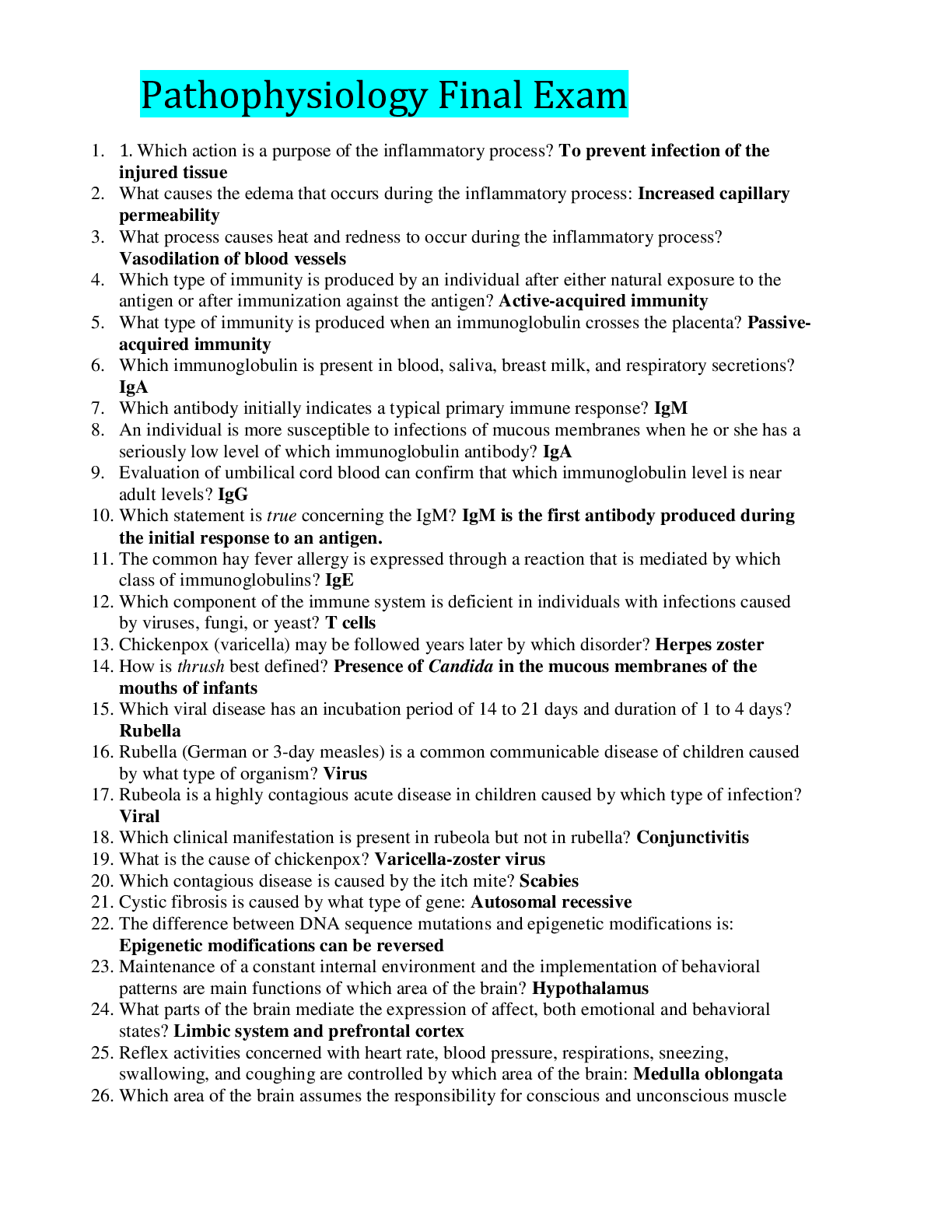
Buy this document to get the full access instantly
Instant Download Access after purchase
Add to cartInstant download
Reviews( 0 )
Document information
Connected school, study & course
About the document
Uploaded On
Dec 17, 2020
Number of pages
12
Written in
Additional information
This document has been written for:
Uploaded
Dec 17, 2020
Downloads
0
Views
45

.png)


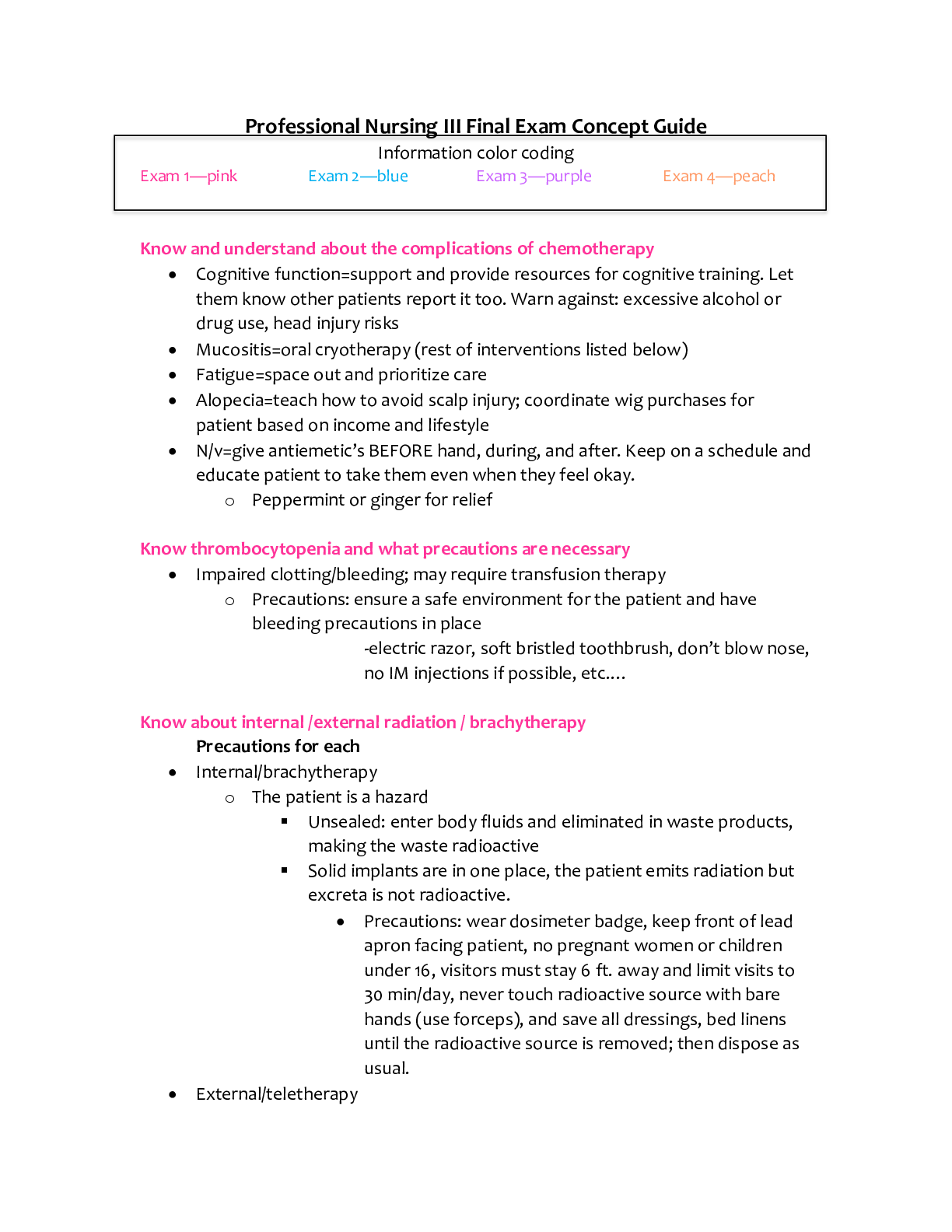

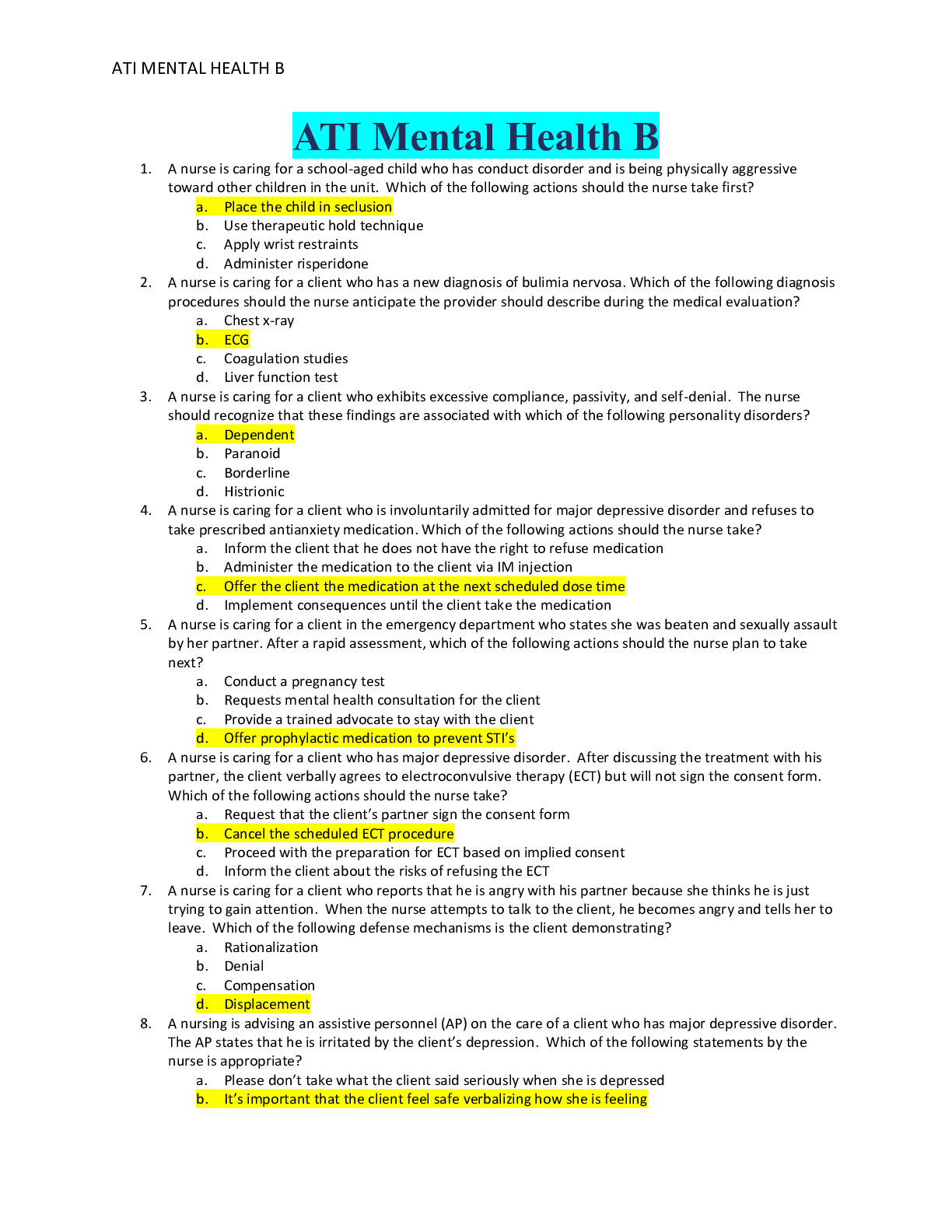
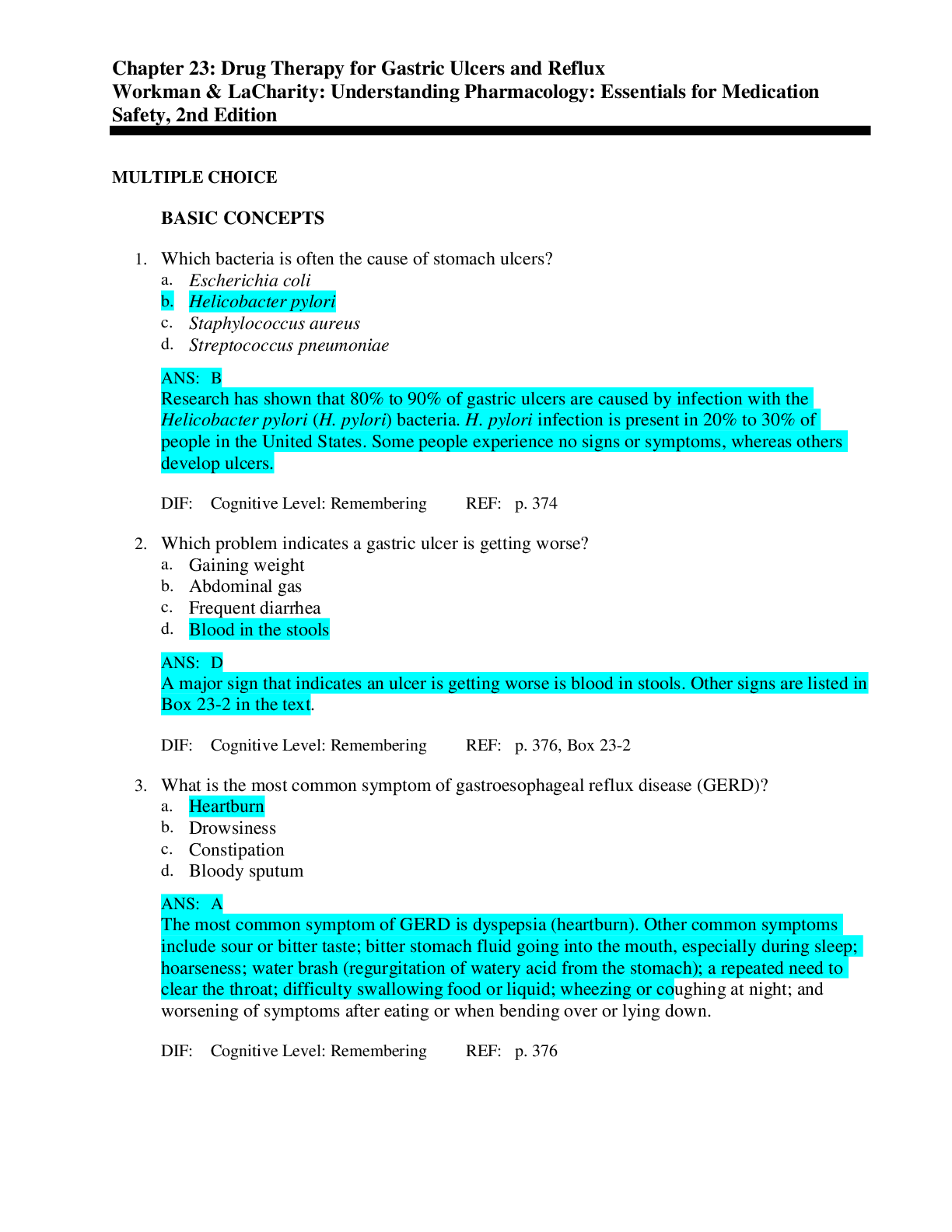
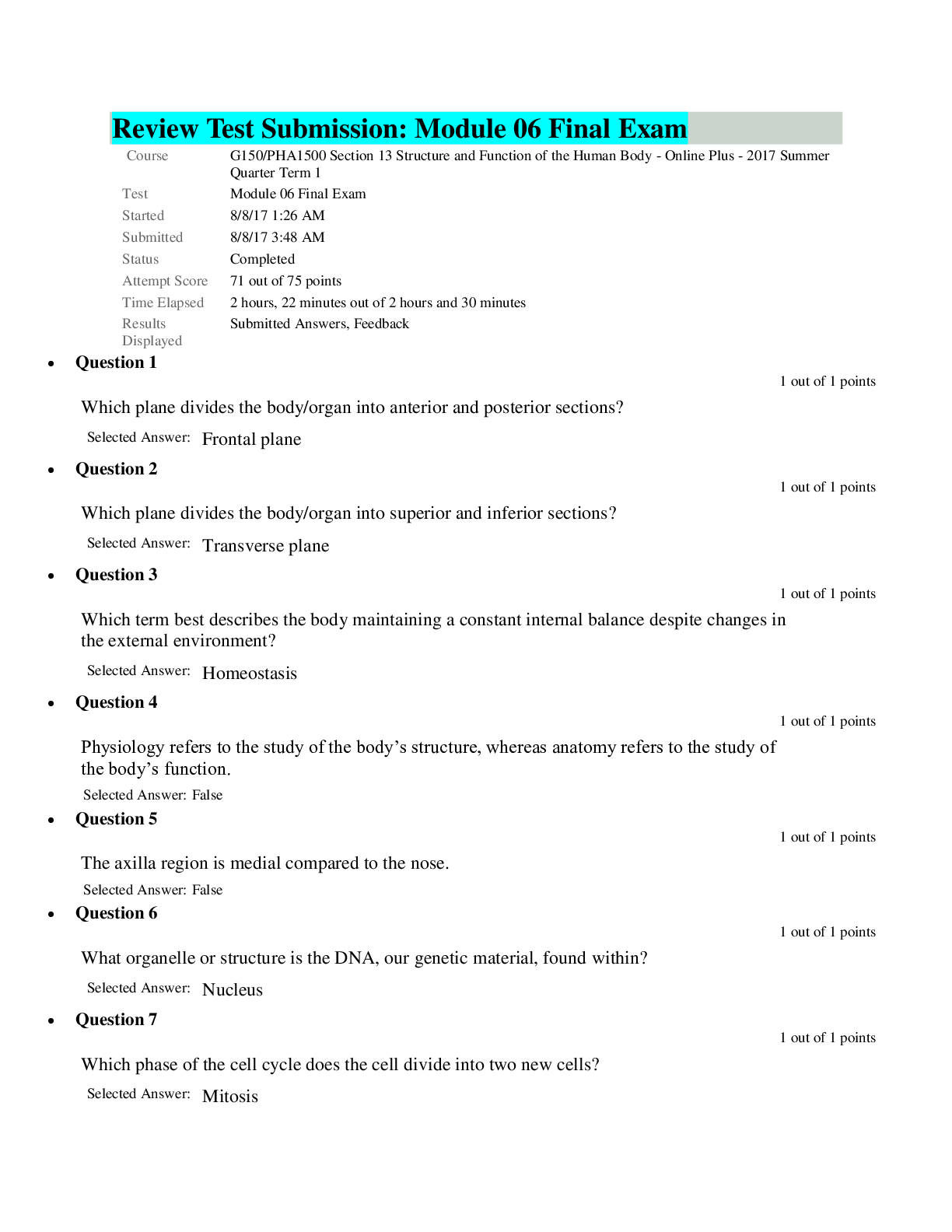
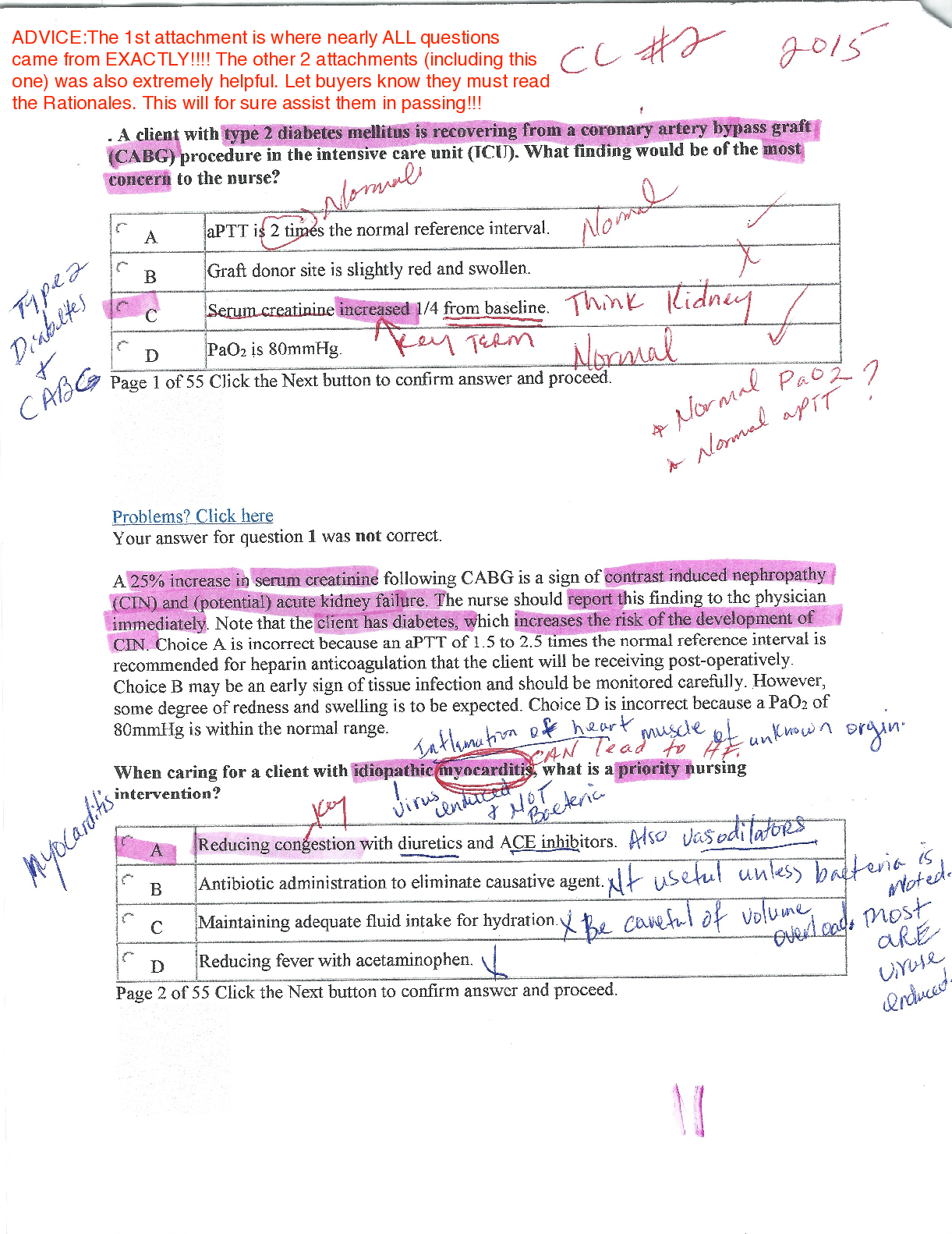
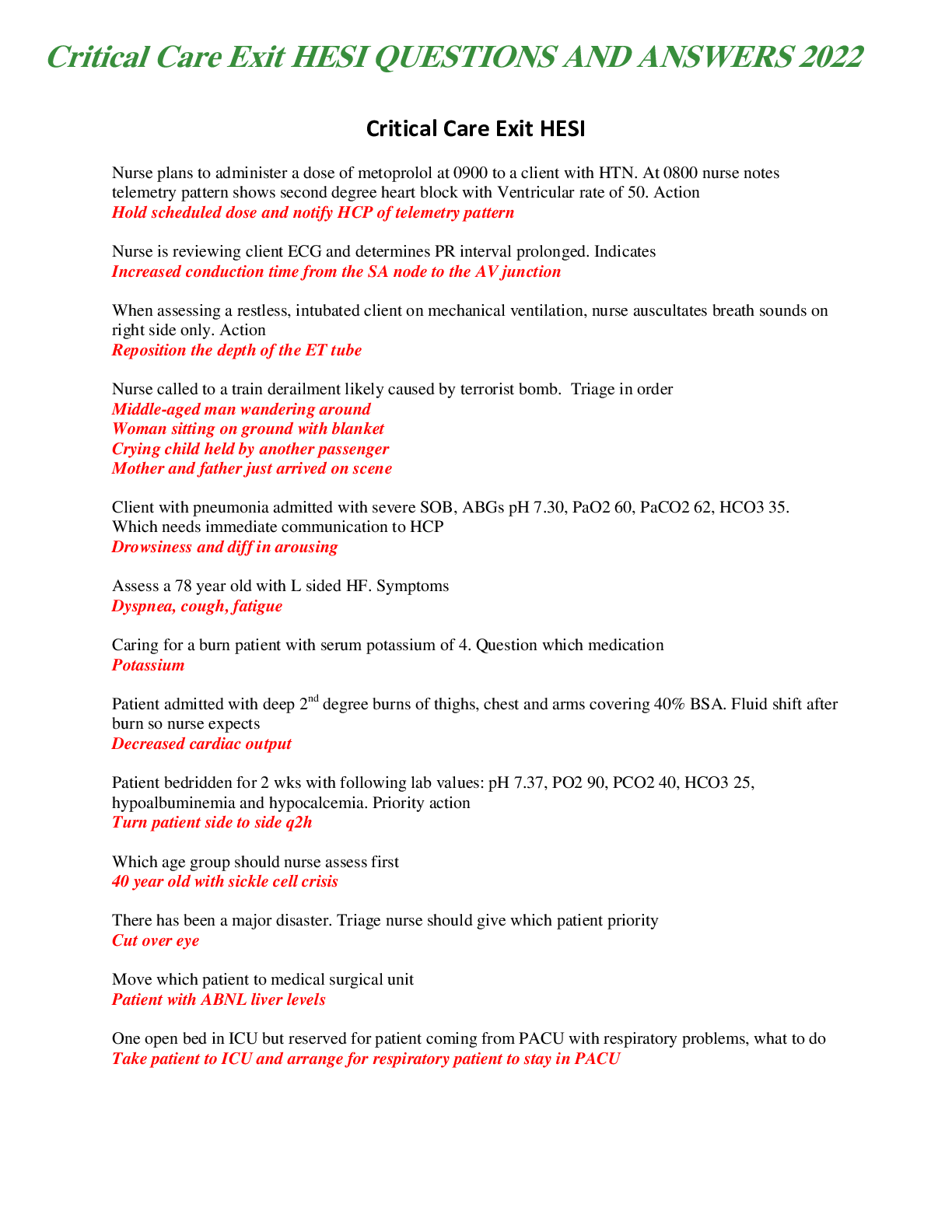

, Correct, Download to Score A.png)
, Latest Questions and Answers with Explanations, All Correct Study Guide, Download to Score A.png)
, All Correct, Download to Score A.png)
 Study Guide.png)
